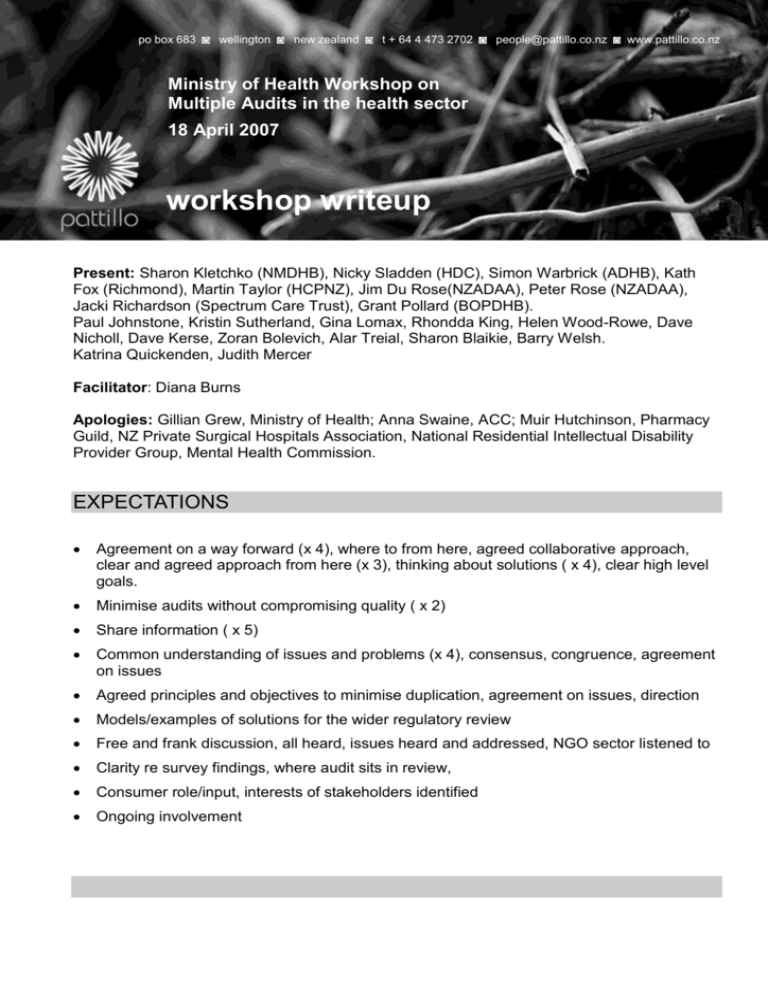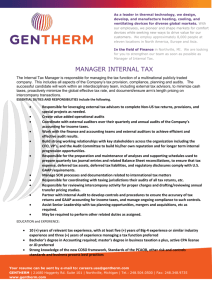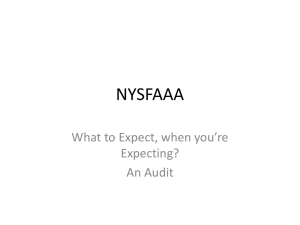expectations - Home | www.ngo.health.govt.nz
advertisement

po box 683 wellington new zealand t + 64 4 473 2702 people@pattillo.co.nz www.pattillo.co.nz Ministry of Health Workshop on Multiple Audits in the health sector 18 April 2007 workshop writeup Present: Sharon Kletchko (NMDHB), Nicky Sladden (HDC), Simon Warbrick (ADHB), Kath Fox (Richmond), Martin Taylor (HCPNZ), Jim Du Rose(NZADAA), Peter Rose (NZADAA), Jacki Richardson (Spectrum Care Trust), Grant Pollard (BOPDHB). Paul Johnstone, Kristin Sutherland, Gina Lomax, Rhondda King, Helen Wood-Rowe, Dave Nicholl, Dave Kerse, Zoran Bolevich, Alar Treial, Sharon Blaikie, Barry Welsh. Katrina Quickenden, Judith Mercer Facilitator: Diana Burns Apologies: Gillian Grew, Ministry of Health; Anna Swaine, ACC; Muir Hutchinson, Pharmacy Guild, NZ Private Surgical Hospitals Association, National Residential Intellectual Disability Provider Group, Mental Health Commission. EXPECTATIONS Agreement on a way forward (x 4), where to from here, agreed collaborative approach, clear and agreed approach from here (x 3), thinking about solutions ( x 4), clear high level goals. Minimise audits without compromising quality ( x 2) Share information ( x 5) Common understanding of issues and problems (x 4), consensus, congruence, agreement on issues Agreed principles and objectives to minimise duplication, agreement on issues, direction Models/examples of solutions for the wider regulatory review Free and frank discussion, all heard, issues heard and addressed, NGO sector listened to Clarity re survey findings, where audit sits in review, Consumer role/input, interests of stakeholders identified Ongoing involvement ISSUES. Group 1 Use of ‘clip on’ audits appreciated by providers Don’t count sector as one unit Multiple funders with their own audit requirements Need to look at costs/benefits for all stakeholders Opportunities to share information on commonly audited info eg staff, governance, financial issues Need to have conversation about common standards Need more analysis by sector/type A lot of interest in audits Irrational concern with upsetting funder/s (audit behaviour) Audits assist improvement Audits duplicate? Don’t know what, how much etc Audit tool overlap Looking for consolidated, integrated approach Surveillance visits – value? Group 2 Single most annoying point, disruptive elements, paperwork, what does this mean fromprviders viewpoint? Concerns re survey size Survey data – too much from aged care sector Are there two sets of underlying issues? Aged care and other? Clarification needed around financial audits (small amount of work for providers) Use survey for further research and analysis Slide of best way forward – areas of duplication – overlap with certification/contractual compliance Pharmacy audits – could we learn something here? MOH/DHB/Medsafe. Group 3 Need to minimise multiple visits Standardise the approach Audit process is valued/balanced against an experience of some disruption for providers Costs associated in meeting audit requirements Issues: how to recruit information that all parties need – only once. Safety when sharing information across agencies Ensure that in any rationalisation, all stakeholders get what they need Enough flexibility to allow case by case management Recognition of certification POSSIBLE SOLUTIONS One whole of government audit agency – generic issues covered, stats for auditors, improve process. Auditors improve process: notice, competency, conflict of interest, common preparation requirements, what are the key parts of service delivery Standards for audit agency and auditors Alignment of sector priorities – auditing for outcomes Identify key parts of service delivery Regional annual audit planning: HealthPac, DSD, SSAs/DHBs, ACC, MSD. Standardisation Information sharing Identify common ground Revisit funding of certification audits Some solutions already happening Cost: initial establishment costs, one off. But less time for provider, reduced audit resource. Drivers: legislations, quality standards, contracts Objectives: quality, safety, fiscal responsibility Fraud prevention. Principles: o Minimise multiple and duplicate audits –with clip on funder tools o Recognise safety act certification o Recognise voluntary certification/accreditation o Potential to include other providers under safety act eg under 5 beds – disability and MH – home care o HealthPac – valuable role for ‘appropriate claiming’ o Funders – issues audits Outcomes: o Cost neutral = less DHB auditing means more workshops and provider development support o Performance information from certification and audits to improve provider quality and improved standards, funding configuration How solutions implemented. Options: o Bottom up – core principles based/ regional solutions. Prioritise sector areas o Top down – one single govt agency, agreeing a common contract. Cost: Neutral for bottom up, expensive for top down. Effectiveness: auditing competencies Trial a solution in aged care eg clip on audits for all DHBs, for period of time (eg 2 years.) Agree KPIs, project team to lead – involvement of stakeholders (eg Healthcare providers NZ). If success, Acc and YPD to join – different audits required here. National Audit Organisation – whole health sector – top slice vote health. Issue based audits – where are they? Consequences: continual improvement, standard approach, reduced cost ultimately, reduced time, improved relationships with shared understanding, trust and confidence in sector, especially for consumers First need principles, this leads to model – model is customisable Involve partnerships Whole of government approach Learn from international experience/best practice Common standards Auditor competency Conflict of stakeholders’ independence? PRIORITIES Need reliable information –moderate auditors, standards of competency etc Aged care sector – trial clip on audits for all DHBs First develop a common model of competency and process, what will it look like, what do we want? Need evaluation and shared understanding. MOH look at best international practice. A time frame- 6 months? Aspirational. Funding- who funds different elements of audits? IS THERE A PROBLEM? Yes, for aged care sector Need more sector analysis – solutions may be sector specific Information not yet clear enough Analysis needs to be fed back There’s a perception of duplication (aged care) Need to establish clear principles eg how to improve funding decisions in each place Get runs on the board now, eg agreement to be more integrated, and of benefits Know and accommodate interests of all groups involved eg DHBs need confidence in reliable info Some things we can do now, eg principles. Others require waiting. PRINCIPLES –ANY PROPOSED SOLUTION MUST MEET THESE More integration Focus on improvement over time – process, outcome, providers. System must be right Natural justice eg right to respond Auditors’ code of conduct Independent, consistent and fair, eg complaints process Cost effective (but this needs to be defined) Minimise visits to providers, while still getting high quality information Information sharing Standardisation of audit tools/process Compliance with existing legislation eg privacy Extra notes (provided by Sharon Kletchko) What should be the next steps? 1. Principles: a. Greater/better integration as a key principle b. competent provision c. support improvement over time process, outcome, providers, system must be right d. add value e. fiscal/cost neutral i.e. cost-effective f. information should be shared for the purpose of quality improvement g. consensus-based h. Standardisation of the audit process and tools (moderation, accreditation, certification) as key principle i. open disclosure j. independent, consistent and fair k. reliability l. competency m. agreed code of conduct 2. Benefits: a. i.e. Better quality of care provided b. funds reinvested in services 3. Mechanisms: What are the priorities? Reliability of information should be addressed through process improvement; standards; competencies Trial with Aged care sector Principles need to be developed common model (accountabilities, competencies as well as process) agreed agreed common benefits / benefits realisation (shared understanding) Development of set of standards/competencies for auditors Timeframe – indicative Funding (i.e. provider funding for certification) and conflicts (need to look at international experience).






